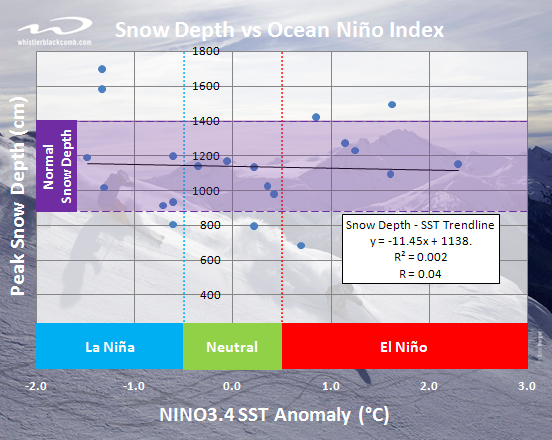La Nina and its Effects on Snow Conditions at Whistler-Blackcomb

When I was living in BC I remember getting an email from Whistler-Blackcomb promoting their EDGE card before the ski season had even begun. It’s almost expected they would send an email to me, as I went the year before, but the unexpected thing about this email was they referenced the La Nina phenomena as reason to expect more-than-average snow fall for the season. I always thought the El Nino/La Nina climate phenomena was unknown to most people, but here was a ski resort trying to profit off it from the public.
Another epic season of snow is expected at Whistler Blackcomb as meteorologists are once again predicting a La Niña winter for the 2011.2012 ski season. For Western Canada, the La Niña weather pattern typically means cooler than normal temperatures and consistent heavy precipitation during the winter months. Last season, these ideal conditions resulted in near record breaking snowfall at Whistler Blackcomb. With a total accumulation of 1579 centimetres or 51.8 feet, the 2010.2011 winter was the second snowiest season on record, bringing the annual snowfall average up to1042 centimetres or 34.1 feet…
Two questions arise which I will hopefully answer in this post:
- What impact does the La Nina phenomena, or more broadly, the El Nino-Southern Oscillation (ENSO), have on BC climate?
- How reliable of an indicator is the ENSO for snowfall at Whistler?
If you are not familiar with El Nino/La Nina, I have written an introduction article.
1. What impact does La Nina have on BC Climate?
Judging by the La Nina and El Nino regional maps shown below, we can expect the following for British Columbia / Whistler:
- Colder and wetter conditions during La Nina (more snow)
- Warmer conditions during El Nino (less snow, or average)
El Nino

La Nina

2. How reliable of an indicator is the ENSO for snowfall at Whistler?
I created a scatter plot to show the correlation between peak snow depth at Whistler-Blackcomb and the ONI (1991-2011). If you include La Nina, Neutral and El Nino conditions, there is effectively no correlation as seen by the correlation factor of 0.04. However, if we only include La Nina and Neutral conditions, the correlation factor is 0.52 (a moderately strong correlation).


How can we explain for this difference? The easy answer is my data set is relatively small, but we should go back to what impacts the ENSO has on Western Canada.
- La Nina results in colder and wetter winters. This means snow may begin accumulating in Whistler earlier (normal rain falls as snow due to the cold), and we can expect more snow (due to the wetness).
- El Nino results in warmer winters, but this does not mean drier winters or less snow accumulation at Whistler. Given that the highest lift at Whistler is located 2000 m above sea level, the warmer temperatures in an El Nino phase may not be enough to cause precipitation to fall as rain instead of snow at Whistler. This may not be the case for the local ski mountains in Vancouver which sit at a lower elevation. During the 2010 Winter Olympics at Vancouver, Cypress Mountain had a lower than average snow base which has often been attributed to El Nino.
Conclusion
In summary, it looks like La Nina conditions may result in more than average snowfall at Whistler, but its El Nino counter partner does not necessarily lead to less snowfall. Given the limited data set, it’s hard to say if these results are truly statistically significant. But for now it looks like it is hard to ignore.
Data disclaimer
- Snow depth values were taken from Whistler’s website: http://www.whistlerblackcomb.com/weather/stats/index.htm
- Normal snow depth was defined by a confidence interval with 1 standard deviation.
- The ONI values used in the plots were the averages for November-February of the season. This is often the peak of La Nina and El Nino episodes.
- The most common index for ENSO seems to be the ONI (difference in current ocean temperature vs average ocean temperature). Another measure is the Multivariate ENSO Index (MEI). Along with sea temperature differences, it combines additional factors such as sea-level pressure, surface air temperature, and cloudiness fraction of the sky. It may lead to a more accurate correlation between ENSO and snow depth at Whistler.









Leave your response!